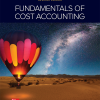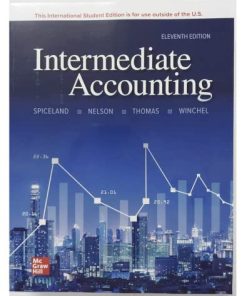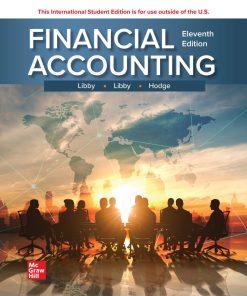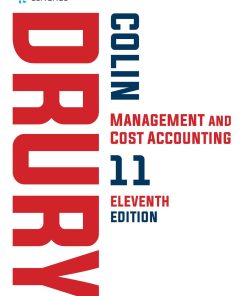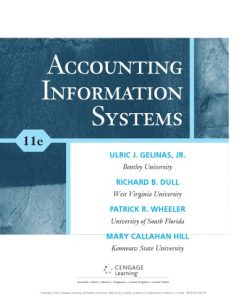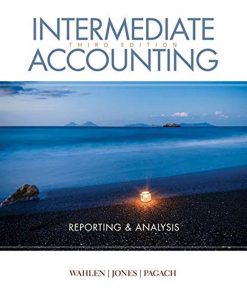Intermediate Accounting 11th Edition by David Spiceland, Mark Nelson, Wayne Thomas, Jennifer Winchel 1264387407 9781264387403
$50.00 Original price was: $50.00.$25.00Current price is: $25.00.
Intermediate Accounting 11th Edition by David Spiceland, Mark Nelson, Wayne Thomas, Jennifer Winchel 1264387407 9781264387403 – Ebook PDF Instant Download/DeliveryISBN:
Full download Intermediate Accounting 11th Edition after payment.
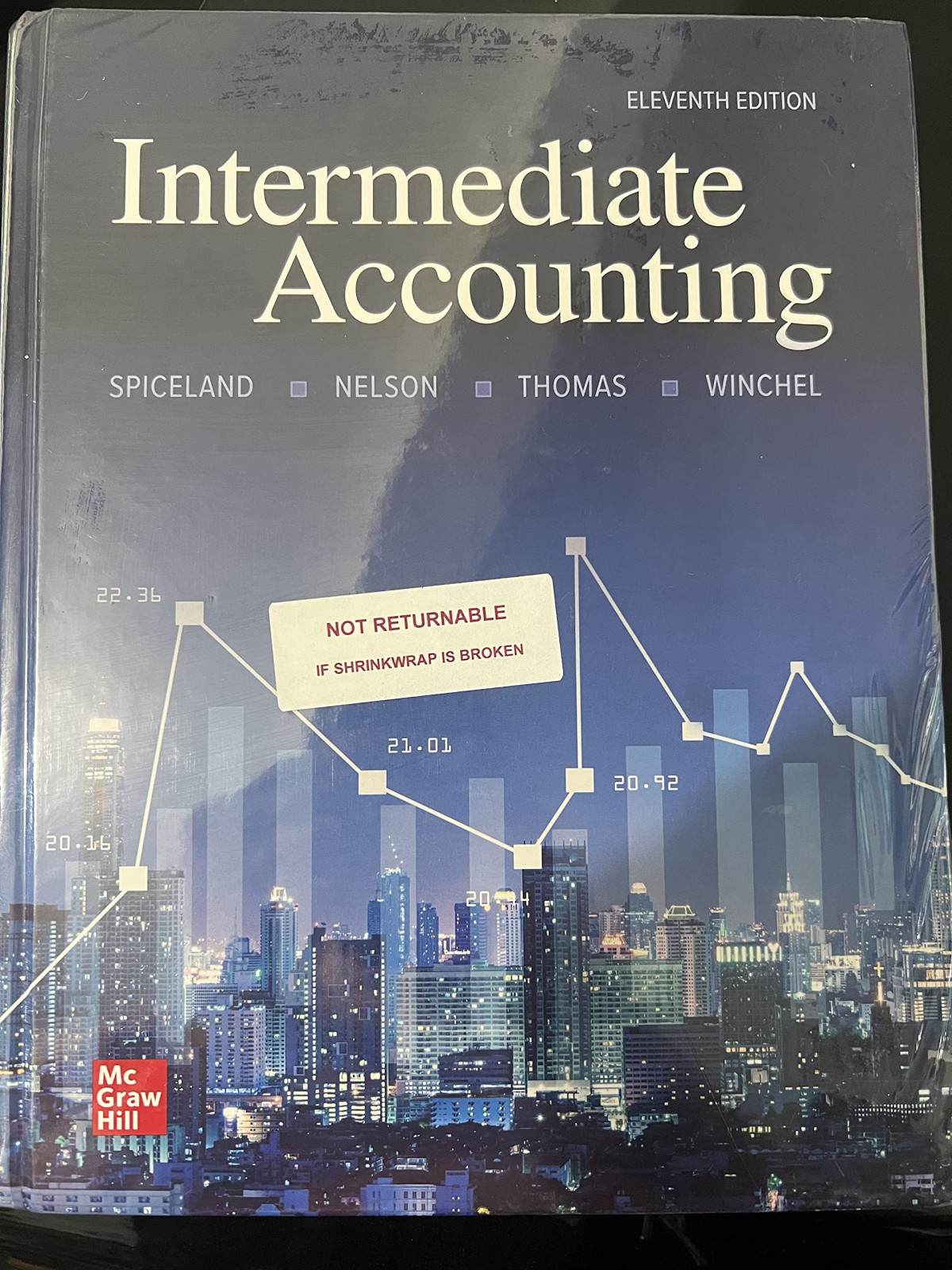
Product details:
ISBN-10 : 1264387407
ISBN-13 : 9781264387403
Author : David Spiceland, Mark Nelson, Wayne Thomas, Jennifer Winchel
The Spiceland/Nelson/Thomas/Winchel author team has created the new standard in Intermediate Accounting by providing students with the most accessible comprehensive and current Intermediate Accounting learning system. The rigorous yet readable approach has won over instructors across the country while the conversational and consistent voice of this highly dedicated and deeply engaged author team has significantly improved student understanding. The Spiceland team is committed to providing current comprehensive and clear coverage of Intermediate Accounting and the newest edition continues to leverage Connect as the premier digital teaching and learning tool on the market. Spiceland/Nelson/Thomas/Winchel’s Intermediate Accounting excels in fully preparing students for the CPA exam and their future careers through the materials’ highly acclaimed conversational writing style carefully tuned pedagogy and wealth of online tools. The authors help students develop a better understanding of both theoretical and practical concepts guiding them to a more complete mastery of accounting principles.
Intermediate Accounting 11th Table of contents:
Section 1: The Role of Accounting as an Information System
Chapter 1: Environment and Theoretical Structure of Financial Accounting
Part A: Financial Accounting Environment
The Economic Environment and Financial Reporting
The Investment-Credit Decision—A Cash Flow Perspective
Cash versus Accrual Accounting
The Development of Financial Accounting and Reporting Standards
Historical Perspective and Standards
The Standard-Setting Process
Encouraging High-Quality Financial Reporting
The Role of the Auditor
Financial Reporting Reform
A Move Away from Rules-Based Standards?
Ethics in Accounting
Part B: The Conceptual Framework
Objective of Financial Reporting
Qualitative Characteristics of Financial Reporting Information
Fundamental Qualitative Characteristics
Enhancing Qualitative Characteristics
Key Constraint: Cost Effectiveness
Elements of Financial Statements
Underlying Assumptions
Economic Entity Assumption
Going Concern Assumption
Periodicity Assumption
Monetary Unit Assumption
Recognition, Measurement, and Disclosure Concepts
Recognition
Measurement
Disclosure
Evolving GAAP
Chapter 2: Review of the Accounting Process
The Basic Model
The Accounting Equation
Account Relationships
The Accounting Processing Cycle
Brief Overview of Accounting Processing Cycle
Illustration of Accounting Processing Cycle
Journal, Ledger, and Trial Balance
Concept Review Exercise: Journal Entries for External Transactions
Adjusting Entries
Prepayments
Accruals
Estimates
Concept Review Exercise: Adjusting Entries
Preparing the Financial Statements
The Income Statement and the Statement of Comprehensive Income
The Balance Sheet
The Statement of Cash Flows
The Statement of Shareholders’ Equity
The Closing Process
Concept Review Exercise: Financial Statement Preparation and Closing
Conversion from Cash Basis to Accrual Basis
Appendix 2A: Using a Worksheet
Appendix 2B: Reversing Entries
Appendix 2C: Subsidiary Ledgers and Special Journals
Chapter 3: The Balance Sheet and Financial Disclosures
Part A: The Balance Sheet
Usefulness
Limitations
Classification of Elements
Assets
Liabilities
Shareholders’ Equity
Concept Review Exercise: Balance Sheet Classification
Part B: Annual Report Disclosures
Disclosure Notes
Summary of Significant Accounting Policies
Subsequent Events
Noteworthy Events and Transactions
Management’s Discussion and Analysis
Management’s Responsibilities
Compensation of Directors and Top Executives
Sustainability Disclosures
Auditor’s Report
Part C: Risk Analysis
Using Financial Statement Information
Liquidity Ratios
Solvency Ratios
Appendix 3: Reporting Segment Information
Chapter 4: The Income Statement, Comprehensive Income, and the Statement of Cash Flows
Part A: The Income Statement and Comprehensive Income
Income from Continuing Operations
Revenues, Expenses, Gains, and Losses
Operating Income versus Nonoperating Income
Income Tax Expense
Income Statement Formats
Earnings Quality
Income Smoothing and Classification Shifting
Operating Income and Earnings Quality
Nonoperating Income and Earnings Quality
Non-GAAP Earnings
Discontinued Operations
What Constitutes a Discontinued Operation?
Reporting Discontinued Operations
Accounting Changes
Change in Accounting Principle
Change in Accounting Estimate
Change in Depreciation, Amortization, or Depletion Method
Correction of Accounting Errors
Prior Period Adjustments
Earnings per Share
Comprehensive Income
Statement of Comprehensive Income
Balance Sheet—Accumulated Other Comprehensive Income
Concept Review Exercise: Income Statement Presentation; Comprehensive Income
Part B: The Statement of Cash Flows
Usefulness of the Statement of Cash Flows
Classifying Cash Flows
Operating Activities
Investing Activities
Financing Activities
Noncash Investing and Financing Activities
Concept Review Exercise: Statement of Cash Flows
Part C: Profitability Analysis
Activity Ratios
Profitability Ratios
Profitability Analysis—An Illustration
Appendix 4: Interim Reporting
Chapter 5: Time Value of Money Concepts
Part A: Basic Concepts
Time Value of Money
Simple versus Compound Interest
Future Value of a Single Amount
Present Value of a Single Amount
Solving for Other Values When FV and PV Are Known
Concept Review Exercise: Valuing a Single Cash Flow Amount
Preview of Accounting Applications of Present Value Techniques—Single Cash Amount
Part B: Basic Annuities
Future Value of an Annuity
Future Value of an Ordinary Annuity
Future Value of an Annuity Due
Present Value of an Annuity
Present Value of an Ordinary Annuity
Present Value of an Annuity Due
Present Value of a Deferred Annuity
Solving for Unknown Values in Present Value Situations
Determining the Annuity Amount When Other Variables Are Known
Determining the Periods When Other Variables Are Known
Determining the Rate When Other Variables Are Known
Determining When Other Variables Are Known—Unequal Cash Flows
Concept Review Exercise: Annuities
Preview of Accounting Applications of Present Value Techniques—Annuities
Valuation of Long-Term Bonds
Valuation of Long-Term Leases
Valuation of Installment Notes
Valuation of Pension Obligations
Summary of Time Value of Money with Excel
Chapter 6: Revenue Recognition
Part A Introduction to Revenue Recognition
Recognizing Revenue at a Single Point in Time
Recognizing Revenue over a Period of Time
Criteria for Recognizing Revenue over Time
Determining Progress toward Completion
Recognizing Revenue for Contracts That Contain Multiple Performance Obligations
Step 2: Identify the Performance Obligation(s)
Step 3: Determine the Transaction Price
Step 4: Allocate the Transaction Price to Each Performance Obligation
Step 5: Recognize Revenue When (or as) Each Performance Obligation Is Satisfied
Concept Review Exercise: Revenue Recognition for Contracts with Multiple Performance Obligations
Part B: Special Issues in Revenue Recognition
Special Issues for Step 1: Identify the Contract
Special Issues for Step 2: Identify the Performance Obligation(s)
Special Issues for Step 3: Determine the Transaction Price
Special Issues for Step 4: Allocate the Transaction Price to the Performance Obligations
Special Issues for Step 5: Recognize Revenue When (or as) Each Performance Obligation Is Satisfied
Disclosures
Part C: Accounting for Long-Term Contracts
Accounting for a Profitable Long-Term Contract
A Comparison of Revenue Recognized over the Term of the Contract and at the Completion of Contract
Long-Term Contract Losses
Concept Review Exercise: Long-Term Construction Contracts
Section 2: Assets
Chapter 7: Cash and Receivables
Part A: Cash and Cash Equivalents
Internal Control
Internal Control Procedures—Cash Receipts
Internal Control Procedures—Cash Disbursements
Restricted Cash and Compensating Balances
Part B: Current Receivables
Accounts Receivable
Initial Valuation of Accounts Receivable
Subsequent Valuation of Accounts Receivable
Concept Review Exercise: Uncollectible Accounts Receivable
Notes Receivable
Short-Term Interest-Bearing Notes
Short-Term Noninterest-Bearing Notes
Long-Term Notes Receivable
Subsequent Valuation of Notes Receivable
Financing with Receivables
Secured Borrowing
Sale of Receivables
Transfers of Notes Receivable
Deciding Whether to Account for a Transfer as a Sale or a Secured Borrowing
Disclosures
Concept Review Exercise: Financing with Receivables
Appendix 7A: Cash Controls
Appendix 7B: Accounting for a Troubled Debt Restructuring
Chapter 8: Inventories: Measurement
Part A: Recording and Measuring Inventory
Types of Inventory
Merchandising Inventory
Manufacturing Inventories
Types of Inventory Systems
Perpetual Inventory System
Periodic Inventory System
A Comparison of the Perpetual and Periodic Inventory Systems
What Is Included in Inventory?
Physical Units Included in Inventory
Transactions Affecting Net Purchases
Inventory Cost Flow Assumptions
Specific Identification
Average Cost
First-In, First-Out (FIFO)
Last-In, First-Out (LIFO)
Comparison of Cost Flow Methods
Factors Influencing Method Choice
LIFO Reserves and LIFO Liquidation
Concept Review Exercise: Inventory Cost Flow Methods
Part B: Methods of Simplifying LIFO
LIFO Inventory Pools
Dollar-Value LIFO
Cost Indexes
The DVL Inventory Estimation Technique
Concept Review Exercise: Dollar-Value LIFO
Advantages of DVL
Chapter 9: Inventories: Additional Issues
Part A: Subsequent Measurement of Inventory
Lower of Cost or Net Realizable Value (LCNRV)
Applying Lower of Cost or Net Realizable Value
Adjusting Cost to Net Realizable Value
Concept Review Exercise: Lower of Cost or Net Realizable Value
Lower of Cost or Market (LCM)
Part B: Inventory Estimation Techniques
The Gross Profit Method
A Word of Caution
The Retail Inventory Method
Retail Terminology
Cost Flow Methods
Other Issues Pertaining to the Retail Method
Concept Review Exercise: Retail Inventory Method
Part C: Dollar-Value LIFO Retail
Concept Review Exercise: Dollar-Value LIFO Retail Method
Part D: Change in Inventory Method and Inventory Errors
Change in Inventory Method
Most Inventory Changes
Change to the LIFO Method
Inventory Errors
When the Inventory Error Is Discovered the Following Year
When the Inventory Error Is Discovered Two Years Later
Concept Review Exercise: Inventory Errors
Earnings Quality
Appendix 9: Purchase Commitments
Chapter 10: Property, Plant, and Equipment and Intangible Assets: Acquisition
Part A: Valuation at Acquisition
Types of Assets
Costs to Be Capitalized
Property, Plant, and Equipment
Intangible Assets
Lump-Sum Purchases
Part B: Noncash Acquisitions
Deferred Payments
Issuance of Equity Securities
Donated Assets
Exchanges
Fair Value Not Determinable
Lack of Commercial Substance
Concept Review Exercise: Exchanges
Part C: Self-Constructed Assets and Research and Development
Self-Constructed Assets
Overhead Allocation
Interest Capitalization
Research and Development (R&D)
Determining R&D Costs
Software Development Costs
R&D Performed for Others
R&D Purchased in Business Acquisitions
Start-Up Costs
Appendix 10: Oil and Gas Accounting
Chapter 11: Property, Plant, and Equipment and Intangible Assets: Utilization and Disposition
Part A: Depreciation, Depletion, and Amortization
Cost Allocation—An Overview
Measuring Cost Allocation
Service Life
Allocation Base
Allocation Method
Depreciation
Time-Based Depreciation Methods
Activity-Based Depreciation Methods
Concept Review Exercise: Depreciation Methods
Partial Period Depreciation
Dispositions
Group and Composite Depreciation Methods
Depletion of Natural Resources
Amortization of Intangible Assets
Intangible Assets Subject to Amortization
Intangible Assets Not Subject to Amortization
Concept Review Exercise: Depletion and Amortization
Part B: Additional Issues
Change in Estimates
Change in Depreciation, Amortization, or Depletion Method
Error Correction
Impairment of Value
Assets Held and Used
Assets Held for Sale
Impairment Losses and Earnings Quality
Concept Review Exercise: Impairment
Part C: Subsequent Expenditures
Expenditures Subsequent to Acquisition
Repairs and Maintenance
Additions
Improvements
Rearrangements
Costs of Defending Intangible Rights
Appendix 11A: Comparison with MACRS (Tax Depreciation)
Appendix 11B: Retirement and Replacement Methods of Depreciation
Chapter 12: Investments
Part A: Accounting for Debt Investments
Example of a Debt Investment
Recording the Purchase of a Debt Investment
Recording Interest Revenue
Three Classifications of Debt Investments
Debt Investments to Be Held-to-Maturity (HTM)
Unrealized Holding Gains and Losses Are Not Recognized for HTM Investments
Sale of HTM Investments
Impairment of HTM Investments
Financial Statement Presentation
Debt Investments Classified as Trading Securities
Adjust Trading Security Investments to Fair Value (2024)
Sale of Trading Security Investments
Financial Statement Presentation
Debt Investments Classified as Available-for-Sale Securities
Comprehensive Income
Rationale for AFS Treatment of Unrealized Holding Gains and Losses
Adjust AFS Investments to Fair Value (2024)
Sale of AFS Investments
Impairment of AFS Investments
Financial Statement Presentation
Comparison of HTM, TS, and AFS Approaches
Transfers between Reporting Categories
Fair Value Option
Concept Review Exercise: Debt Investment Securities
Financial Statement Presentation and Disclosure
Part B: Accounting for Equity Investments
When the Investor Does Not Have Significant Influence: Fair Value through Net Income
Purchase Investments
Recognize Investment Revenue
Adjust Equity Investments to Fair Value (2024)
Sell the Equity Investment
Adjust Remaining Equity Investments to Fair Value (2025)
Financial Statement Presentation
When the Investor Has Significant Influence: The Equity Method
Control and Significant Influence
Purchase of Investment
Recording Investment Revenue
Receiving Dividends
Further Adjustments
Adjustments for Additional Depreciation
No Adjustments for Land or Goodwill
Adjustments for Other Assets and Liabilities
Reporting the Investment
When the Investment Is Acquired in Mid-Year
When the Investee Reports a Net Loss
Impairment of Equity Method Investments
What if Conditions Change?
Fair Value Option
Concept Review Exercise: The Equity Method
Appendix 12A: Other Investments (Special Purpose Funds, Investments in Life Insurance Policies)
Appendix 12B: Impairment of Debt Investments
Section 3: Liabilities and Shareholders’ Equity
Chapter 13: Current Liabilities and Contingencies
Part A: Current Liabilities
Characteristics of Liabilities
What Is a Current Liability?
Open Accounts and Notes
Accounts Payable and Trade Notes Payable
Short-Term Notes Payable
Commercial Paper
Accrued Liabilities
Accrued Interest Payable
Salaries, Commissions, and Bonuses
Liabilities from Advance Collections
Deposits and Advances from Customers
Gift Cards
Collections for Third Parties
A Closer Look at the Current and Noncurrent Classification
Current Maturities of Long-Term Debt
Obligations Callable by the Creditor
When Short-Term Obligations Are Expected to Be Refinanced
Concept Review Exercise: Current Liabilities
Part B: Contingencies
Loss Contingencies
Product Warranties and Guarantees
Litigation Claims
Subsequent Events
Unasserted Claims and Assessments
Gain Contingencies
Concept Review Exercise: Contingencies
Appendix 13: Payroll-Related Liabilities
Chapter 14: Bonds and Long-Term Notes
The Nature of Long-Term Debt
Part A: Bonds
The Bond Indenture
Recording Bonds at Issuance
Determining the Selling Price
Bonds Issued at a Discount
Determining Interest—Effective Interest Method
Amortization Schedule
Zero-Coupon Bonds
Bonds Issued at a Premium
When Financial Statements Are Prepared between Interest Dates
The Straight-Line Method—A Practical Expediency
Concept Review Exercise: Issuing Bonds and Recording Interest
Debt Issue Costs
Part B: Long-Term Notes
Note Issued for Cash
Note Exchanged for Assets or Services
Installment Notes
Concept Review Exercise: Note with an Unrealistic Interest Rate
Financial Statement Disclosures
Part C: Debt Retired Early, Convertible into Stock, or Providing an Option to Buy Stock
Early Extinguishment of Debt
Convertible Bonds
When the Conversion Option Is Exercised
Induced Conversion
Bonds with Detachable Warrants
Concept Review Exercise: Debt Disclosures and Early Extinguishment of Debt
Part D: Option to Report Liabilities at Fair Value
Determining Fair Value
Reporting Changes in Fair Value
Mix and Match
Appendix 14A: Bonds Issued between Interest Dates
Appendix 14B: Troubled Debt Restructuring
Chapter 15: Leases
Part A: Accounting by the Lessor and Lessee
Why Lease?
Lease Classification
Finance Leases and Installment Notes Compared
Finance/Sales-Type Leases
Recording Interest Expense/Interest Revenue
Recording Amortization of the Right-of-Use Asset
Concept Review Exercise: Finance Lease/Sales-Type Lease: No Selling Profit
Sales-Type Leases with Selling Profit
Operating Leases
Recording Lease Expense/Lease Revenue
Reporting Lease Expense and Lease Revenue
Discount Rate
Concept Review Exercise: Operating Lease
Short-Term Leases—A Shortcut Method
Part B: Uncertainty in Lease Transactions
What if the Lease Term Is Uncertain?
What if the Lease Payments Are Uncertain?
What if Lease Terms Are Modified?
Residual Value
Purchase Option
Summary of the Lease Uncertainties
Remeasurement of the Lease Liability
Part C: Other Lease Accounting Issues and Reporting Requirements
Is It a Lease?
Nonlease Components of Lease Payments
Concept Review Exercise: Various Lease Accounting Issues: Finance/Sales-Type Lease
Statement of Cash Flow Impact
Operating Leases
Finance Leases—Lessee
Sales-Type Leases—Lessor
Lease Disclosures
Qualitative Disclosures
Quantitative Disclosures
Appendix 15: Sale-Leaseback Arrangements
Chapter 16: Accounting for Income Taxes
Part A: Temporary Differences
Conceptual Underpinnings
The 4-Step Process
Types of Temporary Differences
Deferred Tax Liabilities
Expense-Related Deferred Tax Liabilities
Balance Sheet and Income Statement Perspectives
Revenue-Related Deferred Tax Liabilities
Deferred Tax Assets
Expense-Related Deferred Tax Assets
Revenue-Related Deferred Tax Assets
Valuation Allowance
Disclosures Linking Tax Expense with Changes in Deferred Tax Assets and Liabilities
Part B: Permanent Differences
Concept Review Exercise: Temporary and Permanent Differences
Part C: Other Tax Accounting Issues
Tax Rate Considerations
When Enacted Tax Rates Differ between Years
Changes in Enacted Tax Laws or Rates
Multiple Temporary Differences
Net Operating Losses
Net Operating Loss Carryforward
Financial Statement Presentation
Balance Sheet Classification
Disclosure Notes
Part D: Coping with Uncertainty in Income Taxes
Intraperiod Tax Allocation
Concept Review Exercise: Multiple Differences and Net Operating Loss
Chapter 17: Pensions and Other Postretirement Benefits
Part A: The Nature of Pension Plans
Defined Contribution Pension Plans
Defined Benefit Pension Plans
Pension Expense—An Overview
Part B: The Pension Obligation and Plan Assets
The Pension Obligation
Accumulated Benefit Obligation
Vested Benefit Obligation
Projected Benefit Obligation
Illustration Expanded to Consider the Entire Employee Pool
Pension Plan Assets
Reporting the Funded Status in the Balance Sheet
Part C: Determining Pension Expense
The Relationship between Pension Expense and Changes in the PBO and Plan Assets
Components of Pension Expense
Income Smoothing
Part D: Reporting Issues
Recording Gains and Losses
Recording the Pension Expense
Reporting Pension Expense in the Income Statement
Recording the Funding of Plan Assets
Comprehensive Income
Income Tax Considerations
Putting the Pieces Together
Settlement or Curtailment of Pension Plans
Concept Review Exercise: Pension Plans
Part E: Postretirement Benefits Other Than Pensions
What Is a Postretirement Benefit Plan?
Postretirement Health Benefits and Pension Benefits Compared
Determining the Net Cost of Benefits
Postretirement Benefit Obligation
Measuring the Obligation
Attribution
Accounting for Postretirement Benefit Plans Other Than Pensions
A Comprehensive Illustration
Concept Review Exercise: Other Postretirement Benefits
Appendix 17: Service Method of Allocating Prior Service Cost
Chapter 18: Shareholders’ Equity
Part A: The Nature of Shareholders’ Equity
Financial Reporting Overview
Paid-in Capital
Retained Earnings
Treasury Stock
Accumulated Other Comprehensive Income
Reporting Shareholders’ Equity on the Balance Sheet
Statement of Shareholders’ Equity
The Corporate Organization
Limited Liability
Ease of Raising Capital
Disadvantages
Types of Corporations
Hybrid Organizations
The Model Business Corporation Act
Part B: Paid-in Capital
Fundamental Share Rights
Distinguishing Classes of Shares
Typical Rights of Preferred Shares
Is It Equity or Is It Debt?
The Concept of Par Value
Accounting for the Issuance of Shares
Par Value Shares Issued for Cash
No-Par Shares Issued for Cash
Shares Issued for Noncash Consideration
More Than One Security Issued for a Single Price
Share Issue Costs
Concept Review Exercise: Expansion of Corporate Capital
Share Repurchases
Shares Formally Retired or Viewed as Treasury Stock
Accounting for Retired Shares
Accounting for Treasury Stock
Resale of Shares
Concept Review Exercise: Treasury Stock
Part C: Retained Earnings
Characteristics of Retained Earnings
Dividends
Liquidating Dividend
Retained Earnings Restrictions
Cash Dividends
Property Dividends
Stock Dividends and Splits
Stock Dividends
Stock Splits
Stock Splits Effected in the Form of Stock Dividends (Large Stock Dividends)
Concept Review Exercise: Changes in Retained Earnings
Appendix 18: Quasi Reorganizations
Section 4: Additional Financial Reporting Issues
Chapter 19: Share-Based Compensation and Earnings per Share
Part A: Share-Based Compensation
Restricted Stock Plans
Restricted Stock Awards
Restricted Stock Units
Stock Option Plans
Recognizing the Fair Value of Options
Forfeitures
When Options Are Exercised
When Unexercised Options Expire
Plans with Graded Vesting
Plans with Performance or Market Conditions
Employee Share Purchase Plans
Concept Review Exercise: Share-Based Compensation Plans
Part B: Earnings per Share
Basic Earnings per Share
Issuance of New Shares
Stock Dividends and Stock Splits
Reacquired Shares
Earnings Available to Common Shareholders
Diluted Earnings per Share
Potential Common Shares
Options, Rights, and Warrants
Convertible Securities
Convertible Bonds
Convertible Preferred Stock
Antidilutive Securities
Options, Warrants, Rights
Convertible Securities
Order of Entry for Multiple Convertible Securities
Concept Review Exercise: Basic and Diluted EPS
Additional EPS Issues
Components of the “Proceeds” in the Treasury Stock Method
Restricted Stock Awards in EPS Calculations
Contingently Issuable Shares
Summary of the Effect of Potential Common Shares on Earnings per Share
Actual Conversions
Financial Statement Presentation of Earnings per Share Data
Concept Review Exercise: Additional EPS Issues
Appendix 19A: Option-Pricing Theory
Appendix 19B: Stock Appreciation Rights
Chapter 20: Accounting Changes and Error Corrections
Part A: Accounting Changes
Change in Accounting Principle
The Retrospective Approach: Most Changes in Accounting Principle
The Modified Retrospective Approach
The Prospective Approach
Change in Accounting Estimate
Changing Depreciation, Amortization, and Depletion Methods
Change in Reporting Entity
Errors
Concept Review Exercise: Accounting Changes
Part B: Correction of Accounting Errors
Prior Period Adjustments
Error Correction Illustrated
Error Discovered in the Same Reporting Period That It Occurred
Error Affecting Previous Financial Statements, but Not Net Income
Error Affecting a Prior Year’s Net Income
Concept Review Exercise: Correction of Errors
Chapter 21: The Statement of Cash Flows Revisited
Part A: The Content and Value of the Statement of Cash Flows
Cash Inflows and Outflows
Structure of the Statement of Cash Flows
Cash, Cash Equivalents, and Restricted Cash
Primary Elements of the Statement of Cash Flows
Cash Flows from Operating Activities
Cash Flows from Investing Activities
Cash Flows from Financing Activities
Reconciliation with Change in Cash Balance
NonCash Investing and Financing Activities
Preparation of the Statement of Cash Flows
Part B: Preparing the SCF: Direct Method of Reporting Cash Flows from Operating Activities
Using a Spreadsheet
Income Statement Accounts
Balance Sheet Accounts
Concept Review Exercise: Comprehensive Review
Part C: Preparing the SCF: Indirect Method of Reporting Cash Flows from Operating Activities
Getting There through the Back Door
Components of Net Income That Do Not Increase or Decrease Cash
Components of Net Income That Do Increase or Decrease Cash
Comparison with the Direct Method
Reconciliation of Net Income to Cash Flows from Operating Activities
Appendix 21A: Spreadsheet for the Indirect Method
Appendix 21B: The T-Account Method of Preparing the Statement of Cash Flows
Appendix A: Derivatives
Appendix B: GAAP Comprehensive Case
Appendix C: IFRS Comprehensive Case
People also search for Intermediate Accounting 11th:
intermediate accounting 11th edition
intermediate accounting 18th edition
intermediate accounting pdf
intermediate accounting 18th edition pdf
intermediate accounting ii
Tags:
Intermediate Accounting,David Spiceland,Mark Nelson,Wayne Thomas,Jennifer Winchel
You may also like…
Business & Economics - Accounting
Business & Economics
Languages - General & Miscellaneous Languages - Reference
Business & Economics - Accounting
Business & Economics - Management & Leadership
Business & Economics - Management & Leadership
Business & Economics - Accounting
Business & Economics - Accounting



